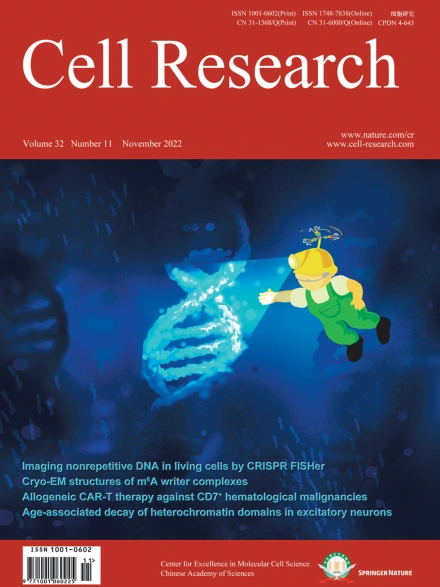
Advanced Search
Submit Manuscript
Advanced Search
Submit Manuscript
Volume 32, No 11, Nov 2022
ISSN: 1001-0602
EISSN: 1748-7838 2018
impact factor 17.848*
(Clarivate Analytics, 2019)
Volume 32 Issue 11, November 2022: 969-981
CRISPR FISHer enables high-sensitivity imaging of nonrepetitive DNA in living cells through phase separation-mediated signal amplification
Xin-Yuan Lyu1,2,3,† , Yuan Deng1,2,4,† , Xiao-Yan Huang1,2,3,† , Zhen-Zhen Li1,2,3,† , Guo-Qing Fang1,2,3 , Dong Yang1,2,3 , Feng-Liu Wang1,2,4 , Wang Kang1,2,3 , En-Zhi Shen1,2,3,4,* , Chun-Qing Song1,2,3,4,*
1Research Center for Industries of the Future, School of Life Sciences, Westlake University, Hangzhou, Zhejiang, ChinaThe dynamic three-dimensional structures of chromatin and extrachromosomal DNA molecules regulate fundamental cellular processes and beyond. However, the visualization of specific DNA sequences in live cells, especially nonrepetitive sequences accounting for most of the genome, is still vastly challenging. Here, we introduce a robust CRISPR-mediated fluorescence in situ hybridization amplifier (CRISPR FISHer) system, which exploits engineered sgRNA and protein trimerization domain-mediated, phase separation-based exponential assembly of fluorescent proteins in the CRISPR-targeting locus, conferring enhancements in both local brightness and signal-to-background ratio and thus achieving single sgRNA-directed visualization of native nonrepetitive DNA loci in live cells. In one application, by labeling and tracking the broken ends of chromosomal fragments, CRISPR FISHer enables real-time visualization of the entire process of chromosome breakage, separation, and subsequent intra- or inter-chromosomal ends rejoining in a single live cell. Furthermore, CRISPR FISHer allows the movement of small extrachromosomal circular DNAs (eccDNAs) and invading DNAs to be recorded, revealing substantial differences in dynamic behaviors between chromosomal and extrachromosomal loci. With the potential to track any specified self or non-self DNA sequences, CRISPR FISHer dramatically broadens the scope of live-cell imaging in biological events and for biomedical diagnoses.
https://doi.org/10.1038/s41422-022-00712-z